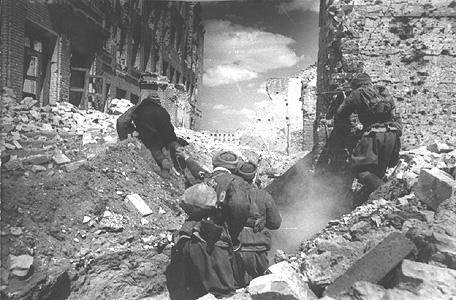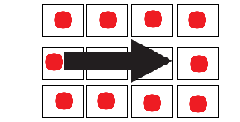Urban Warfare Doctrine
| Survivor Tactics |
| The information on this page or section discusses a survivor strategy. |
| ||||
Urban Warfare Doctrine
Urban Warfare Doctrine is a refinement of the best presented of Dam Tactics and Distributed Defense while addressing potential flaws in both approaches. River Tactics is the complete antithesis of Urban Warfare for River Tactics places emphasis on avoidance as a vital asset while Urban Warfare sees value in direct confrontation like Dam Tactics through the use of a concentrated defense of a particular position. Unlike Dam Tactics, which emphasize a single position as the centerpiece of a defensive position along with the immediate supporting positions and like Distributed Defense Urban Warfare seeks to break from the vulnerabilities of staking one's entire focus on one single spot to defend and, with the loss of that position, the end of the engagement in defeat.
The principle of Urban Warfare Doctrine is inspired by the successful defenses of Stalingrad and Leningrad in World War II against the Third Reich as well as by events in Urban Dead such as the Battle of Santlerville although not specifically formulated in that engagement in the following fashion was a direct inspiration for this approach.
Like in Leningrad and Stalingrad, Urban Warfare seeks to turn an entire suburb as opposed to a single buildings and its immediate supporting positions into a hotly-contested warzone. Instead of, like in Dam Tactics, making the defense do-or-die in one position Urban Warfare instead seeks to make every building in the combat area a fortress to be fought for, held, and forced to be taken by attacking zombie hordes. Such positions should be then held as long as possible, once it is apparent the position will be lost then the survivors inside should fall back to the next nearest prepared defensive position and repeat the process again. Likewise as in Stalingrad or Leningrad once a position is lost does not consign it to continual zombie occupation, rather once the opportunity presents itself a lost building is to be re-taken, occupied, and fortified again forcing invading hordes to fight over the same building multiple times during the course of the engagement.
Basic Theory
In previous stand-up fights where zombie hordes have been beaten the key elements that enabled victory were one of two things: superior numbers as in the Battle of Santlerville or a solid enough position and simply waiting out the enemy long enough as in the case of every successful Mall Siege. Unlike in long-lasting sieges where it becomes a battle of will and grit over control of one or a handful of buildings, by having survivors fight for every building as long as it can hold out and working to retake lost buildings once that is doable it forces the horde assaulting the suburb with one of two choices:
1. Divide their forces: While this in theory could defeat this approach, in truth it would take down many secondary positions while well-stocked, fortified, and defended primary positions would last and most likely beat back the attacking horde
or
2. Concentrate on each strongpoint: This could also work if done quickly and effectively but in the face of regular counter-attacks and reclamation operations this would force the attacking horde to play whack-a-mole with the defending survivors.
In either case eventually the horde's patience would wear out leading to an eventual survivor victory, although it would not come either quickly or easily.
Necessary Elements
For such an approach to work effectively it would require the survivors defending the suburb to have three things nailed down:
1. Effective Communication: Without this it would be difficult to coordinate which positions to hold and which to fall back from as well as where to launch counter-strikes against the enemy. If all the survivors taking part in such an operation are not in effective and regular communication then such tactics would be difficult to employ. Regular communication of new revive points is also needed, as having set revive points during such an engagement would lead to positions that zombies would wait at to strike at revivers.
2. Designated Strike Teams: For the second element, the counter-attacks, to work effectively there must be designated strike teams whose purpose is to conduct recon and launch assaults on lost positions to retake them from enemy forces and pave the way for defenders to re-occupy such positions.
3. Substantial Supplies: While priority should be given to resource buildings, ultimately the survivors would need to stock up on as much in the way of supplies as they possibly could carry with them for an extended engagement, especially first aid kits and syringes. Syringes are especially vital as revives are key to effective survivor resistance in a prolonged engagement and survivors engaging in Urban Warfare must be able to operate for extended periods without a nearby NecroTech building. During such operations you must at all times be able to rely on that which you can take with you.
Priority
Buildings must be ranked in such an engagement according to priority of what is to be defended most heavily first and so on down the line as well as what should be retaken if the opportunity presents itself. While every building should be fortified and protected as much as possible, certain buildings are of inherently higher priority. Defended Resource Buildings should also be regularly looted as much as possible with the assumption that it will no longer be active during your next AP cycle. Below is a list of what is highest to lowest and why:
1. Necrotech Facilities: Without a doubt the most vital in any extended engagement for access to syringes and syringe manufacture.
2. Malls: Having access to nearly everything but syringes, fuel, flak jackets, and DNA Scanners as well as skills allowing higher rates of success when searching, holding Malls, while difficult, is vital to any extended operation. Remember that Malls are not the end-all be-all of any given defense and if the Mall appears it cannot be held it must be evacuated as quickly as possible to nearby fallback points. However, with recent updates, using the Malls for First Aid Kits is not quite as good of an idea now.
3. Police Stations and Hospitals: Both are equally important for they can serve as a vital source of medical and military supplies during any engagement, both of which are of higher priority during open engagements.
4. Auto Repair Shops, Fire Stations, and Factories: Lower priority while Fire Stations give some access to medical supplies and fire axes any involved in the siege should already have a fire ax due to its supreme advantage in extended operations of not needing ammunition and first aid kits are more easily found in other locations. Auto Repair Shops and Factories may give access to fuel and generators but these are lower priority in extended operations compared to the means to engage the enemy especially since no position is expected to hold out for the duration of the engagement. Toolkits, while similarly valuable, should already be in your possession at the outset and there are better places to search for them such as malls. That said, regaining fuel and generators is very useful for keeping radios going and for the use of Surgery, but is not as high as priority as supplies you can take with you.
5. All other buildings: While not really capable of giving reliable or useful supplies, every other building has an asset that makes them worth defending: they can be barricaded and used for Free Running. If any of the above positions are lost to defenders, there is nothing wrong with holding back zombie hordes from a church, office tower, or nightclub.
Criticism
Urban Warfare can be seen as an incredibly dangerous and foolhardy approach by those who advocate River Tactics and its derivatives. Urban Warfare is aimed at direct and open confrontation and as such criticism in that regard is rather pointless as Urban Warfare is the polar opposite of River Tactics in many ways. Some might say it is less effective than Dam Tactics, like the common criticism of Distributed Defense that it is too involved to be workable. In truth while it requires more communication and coordination than Dam Tactics, it does not have the risk inherent in Dam Tactics of total defeat from the loss of the focal point of the defensive position.
Supporters
Any who support the use of Urban Warfare Doctrine show it by putting the following template in your group or profile:
| Supporter of Urban Warfare Doctrine | |
| I fight block by block |
{{UWD}}
and your page will be added to the list of supporters of this approach.

